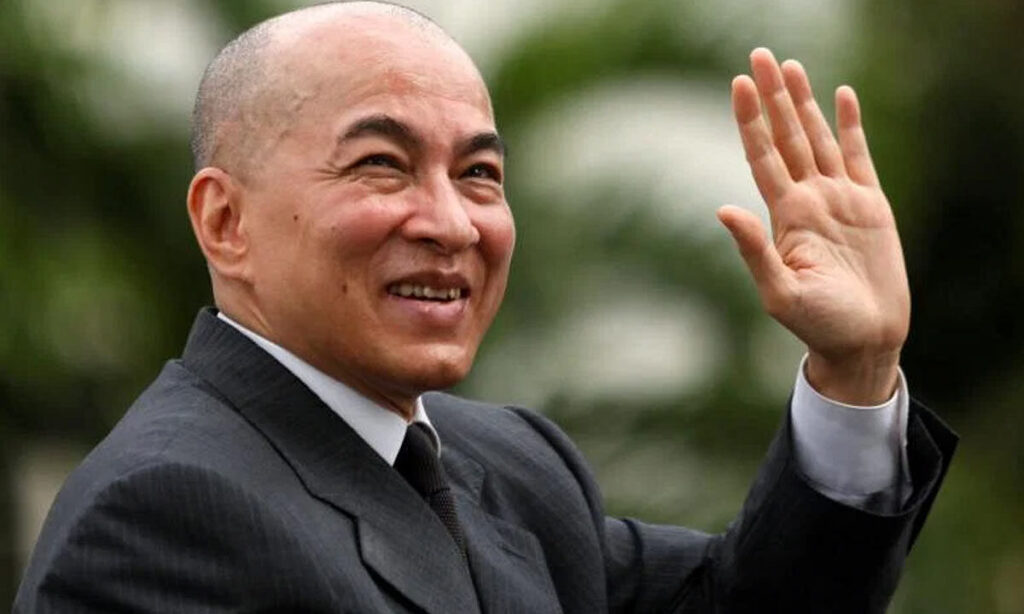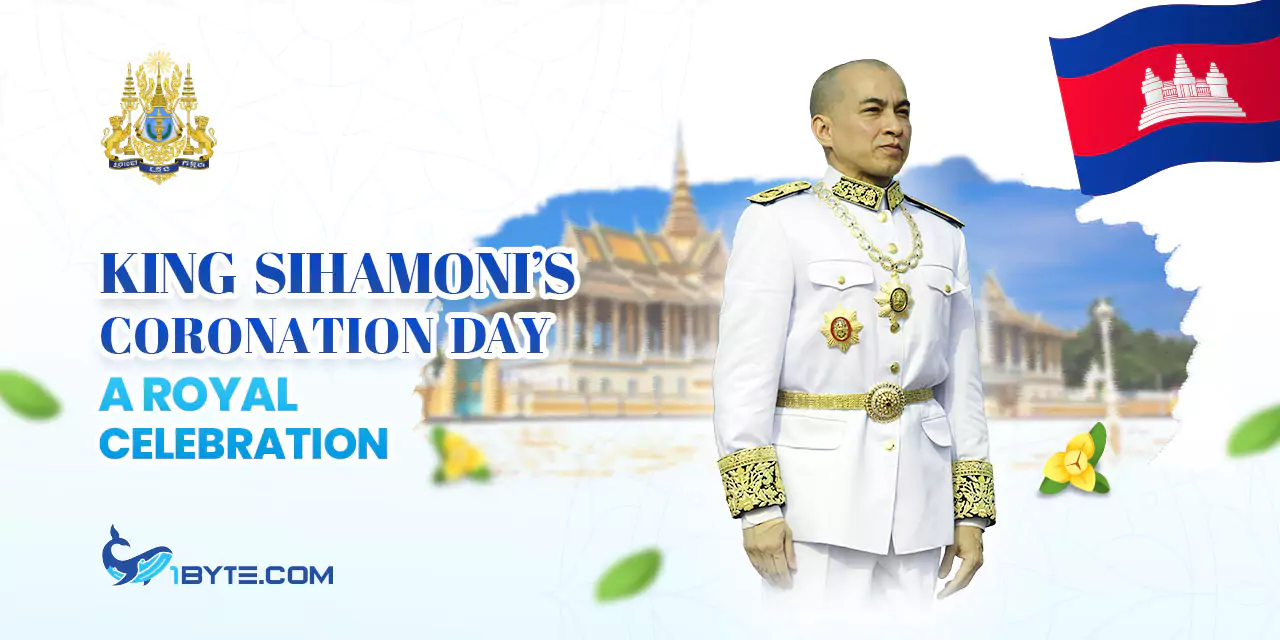King Sihamoni’s Coronation Day holds a special place in Cambodia’s heart. It’s a time of grandeur and tradition. On this remarkable day, King Sihamoni ascends to the throne, marking the continuation of a rich royal legacy. This article from 1Byte explores the grand celebrations and cultural significance of this momentous occasion.
Historical Context
In order to fully appreciate the significance of King Coronation Day, it’s crucial to delve into its historical context. Cambodia’s monarchy, steeped in tradition, has played a pivotal role throughout its history. Understanding this background illuminates the true importance of the coronation day and King Sihamoni’s role in continuing this legacy.
FURTHER READING: |
| 1. What's in Store for Halloween 2024? |
| 2. Gratitude for Dad: Celebrate Father's Day on June 18th with 1Byte |
| 3. Water Festival Travel Guide: What You Need to Know for Cambodia 2025 |
A brief background on Cambodia’s monarchy
The historical context of King Sihamoni’s Coronation Day is deeply rooted in Cambodia’s rich history. Dating back to at least 68 AD, the monarchy, officially known as the Kingdom of Cambodia, has been a prominent institution in the country. The King of Cambodia serves as both the head of state and the head of the ruling Royal House of Norodom, and this tradition has endured for centuries.
Notably, the monarchy faced a brief period of abolition from 1970 to 1993. However, since 1993, Cambodia has embraced an elective monarchy system, making it one of the few countries in the world to follow this unique approach. The King is elected for life by the Royal Council of the Throne, consisting of esteemed political and religious figures. Candidates for the throne must be male descendants of King Ang Duong, aged at least 30, and belong to either the House of Norodom or the House of Sisowath, two of Cambodia’s royal houses.
To understand the importance of King Coronation Day, it’s crucial to acknowledge Cambodia’s modern history, which traces back to 1863 when the country came under French colonial rule. Norodom Prohmbarirak, often regarded as the first modern Khmer king, played a pivotal role in this era. As the eldest son of King Ang Duong, he safeguarded Cambodia from being absorbed by neighboring Siam and Vietnam.
In 1947, Cambodia adopted a constitutional monarchy, marking a significant development in its political structure. Despite occasional periods of political turmoil and conflict, the monarchy has maintained its importance in Cambodian society. However, it’s essential to note that in contemporary Cambodia, the King’s role is primarily symbolic. This historical context sets the stage for understanding the significance of King Sihamoni’s Coronation Day and the enduring traditions associated with it.
King Sihamoni’s Coronation Day
King Sihamoni’s Coronation Day, a historic event, unfolded on October 29, 2004. This three-day ceremony commenced on October 28, 2004, with immense significance and an array of traditional rituals and symbolism.
On the morning of October 29, 2004, King Sihamoni’s parents, retired King Norodom Sihanouk and Queen Monineath, bathed him using water sourced from Phnom Kulen in Siem Reap province. In the afternoon, King Sihamoni was carried through the Royal Palace grounds on a splendid golden palanquin during a vibrant procession.
His ascension to the throne was accompanied by Brahmanic prayers, invoking blessings from the tevadas, or angels, which added to the ceremony’s symbolism, coinciding with the full moon.
After his coronation, King Sihamoni promptly began fulfilling his commitments to serve the nation faithfully, making his inaugural royal visit to the countryside just days after his coronation, specifically to Kampong Speu province on November 3, 2004.
As a testament to its importance, King Sihamoni’s Coronation Day is now an annual commemoration in Cambodia, celebrating the continuity of the royal legacy and the country’s enduring cultural heritage.
King Sihamoni’s Reign
King Sihamoni’s Coronation Day marked the beginning of a new era for Cambodia. His reign has been characterized by a commitment to serving the nation and preserving its cultural heritage. Exploring King Sihamoni’s reign provides insight into his impact on modern Cambodia and the enduring significance of this royal celebration.
King Sihamoni’s role and reign
King Sihamoni’s role and reign as the King of Cambodia have been marked by a unique blend of tradition and modernity. He ascended the throne on October 14, 2004, succeeding his father, King Norodom Sihanouk, and becoming the fourth monarch from the royal House of Norodom.
Prior to his coronation, King Sihamoni served as Cambodia’s ambassador to the United Nations and UNESCO, showcasing his commitment to international diplomacy and cultural advocacy. His education in Czechoslovakia and his work as a cultural ambassador in Europe, along with his background as a classical ballet instructor during his time as a prince, reflect his deep connection to the arts and culture.

During his reign, King Sihamoni has not only continued his cultural advocacy but has also actively supported various philanthropic causes. His approach is characterized by being “close to the people and having a gentle touch,” earning him praise for his approachable and empathetic leadership.
While King Sihamoni’s father, former King Sihanouk, held a significant role, King Sihamoni has been carving out his own distinct role as a monarch. His reign has witnessed noteworthy changes within the palace and in Cambodian society. The traditional rituals and ceremonies that marked his ascension to the throne underscore his commitment to preserving Cambodia’s deep cultural heritage, making him a unique and respected figure in the nation’s history.
King Sihamoni’s noteworthy achievements and contributions
King Sihamoni’s reign has been marked by a series of noteworthy achievements and contributions that reflect his dedication to Cambodia and its people.
His commitment to cultural advocacy, evident during his tenure as Cambodia’s ambassador to the United Nations and UNESCO, has continued throughout his reign. His work as a cultural ambassador in Europe and as a classical ballet instructor underscores his deep connection to the arts and culture, which he actively promotes.
King Sihamoni is known for his support of various philanthropic causes, and his approach as a compassionate leader who is “close to the people” with a gentle touch is widely appreciated.
In the realm of international diplomacy, King Sihamoni has been proactive. His address to UNESCO’s General Assembly highlights his dedication to the preservation, protection, and development of culture, economy, society, and science on a global scale.
Balancing his role as a constitutional monarch in the context of Cambodia’s evolving political landscape, King Sihamoni has demonstrated his ability to chart his path as a distinct monarch, notwithstanding the influential role of his father, former King Sihanouk. King Sihamoni’s reign is marked by a harmonious blend of tradition, philanthropy, diplomacy, and a unique royal legacy.
Public Celebrations
Public celebrations surrounding King Sihamoni’s Coronation Day are a vibrant and integral part of this royal event. These celebrations are a reflection of the deep cultural and historical ties that connect the Cambodian people with their monarchy.
Leverage 1Byte’s strong cloud computing expertise to boost your business in a big way
1Byte provides complete domain registration services that include dedicated support staff, educated customer care, reasonable costs, as well as a domain price search tool.
Elevate your online security with 1Byte's SSL Service. Unparalleled protection, seamless integration, and peace of mind for your digital journey.
No matter the cloud server package you pick, you can rely on 1Byte for dependability, privacy, security, and a stress-free experience that is essential for successful businesses.
Choosing us as your shared hosting provider allows you to get excellent value for your money while enjoying the same level of quality and functionality as more expensive options.
Through highly flexible programs, 1Byte's cutting-edge cloud hosting gives great solutions to small and medium-sized businesses faster, more securely, and at reduced costs.
Stay ahead of the competition with 1Byte's innovative WordPress hosting services. Our feature-rich plans and unmatched reliability ensure your website stands out and delivers an unforgettable user experience.
As an official AWS Partner, one of our primary responsibilities is to assist businesses in modernizing their operations and make the most of their journeys to the cloud with AWS.
How the coronation day is celebrated by the public
The celebration of King Sihamoni’s Coronation Day is a grand and joyful occasion in Cambodia. The public comes together on October 29th each year, marking this day as a national holiday filled with cultural significance.
Parades are a prominent part of the celebrations, featuring vibrant displays of traditional Cambodian music and dance that captivate the spectators. The streets come alive with color and rhythm, reflecting the country’s rich heritage.
As the day turns into night, spectacular fireworks displays illuminate the sky, adding to the festive atmosphere and creating a visual spectacle that resonates with the people.
Various entertainment events, including concerts, performances, and cultural displays, provide a diverse array of experiences for those celebrating King Sihamoni’s Coronation Day. These events offer an opportunity for both locals and visitors to immerse themselves in Cambodian culture and traditions.
At the heart of the festivities lies a ceremony at the Royal Palace’s Throne Hall, a place of great historical and cultural significance. In the past, this ceremony has been presided over by Queen Mother Norodom Monineath Sihanouk, emphasizing the royal connection to the people.
These celebrations are a testament to the deep love and admiration the people of Cambodia hold for their king. King Sihamoni’s Coronation Day serves as a cherished reminder of the enduring and significant role of the monarchy in Cambodian society, uniting the nation in a spirit of pride and cultural heritage.

